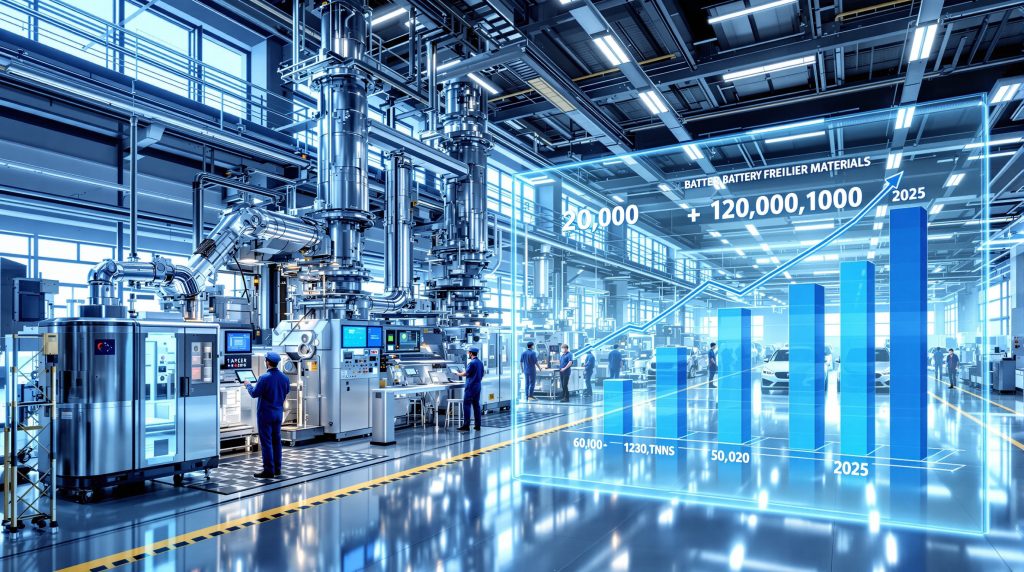The Strategic Importance of South Korea's New Battery Precursor Plant
South Korea's battery manufacturing landscape has undergone a significant transformation with the recent completion of LLBS's Korean plant for battery precursor materials in Gunsan. This strategic facility, which finished construction at the end of September 2025, represents a crucial development in the nation's efforts to secure its position in the global battery supply chain. By establishing domestic production capabilities for precursor materials, South Korea is taking decisive action to reduce its dependence on Chinese suppliers, which currently control approximately 80% of the global precursor market.
The LLBS plant, situated within the Saemangeum National Industrial Complex in North Jeolla Province, has received full operational approval as of April 2025 and is set to begin trial production before the end of the year. This facility addresses a critical vulnerability in South Korea's battery metals investment value chain by completing the loop between raw material processing and cathode production using entirely domestic technology.
LS Group Chairman Koo Ja-eun emphasized the strategic importance of this development, stating that the aim is to "reduce reliance on China for the precursor market" and "lead the global supply chain with purely domestic technology." He further noted that the core hub in Saemangeum will become "the heart of Korean battery materials."
Key Production Targets and Capacity Growth
The LLBS facility follows an ambitious scaling strategy with clearly defined production milestones:
- Initial trial production beginning in late 2025
- Targeted production of 20,000 tonnes by 2026
- Expansion to 40,000 tonnes by 2027
- Ultimate goal of 120,000 tonnes annually by 2029
At full capacity, the plant will produce sufficient precursor materials to support approximately 1.3 million electric vehicles annually, representing a significant contribution to global EV battery supply chains.
Strategic Location and Industrial Integration
The selection of Gunsan's Saemangeum National Industrial Complex as the facility location was no accident. This strategic positioning creates a synergistic ecosystem with other battery-related facilities in the region, most notably LS MnM's upcoming nickel sulfate production facility, which will be operational by 2029 with an annual capacity of 62,000 tonnes.
This integration exemplifies South Korea's comprehensive approach to battery supply chain development:
- LS MnM produces nickel sulfate from raw materials
- LLBS converts nickel sulfate into precursor materials
- L&F processes precursors into cathode materials
- Korean battery manufacturers integrate these components into finished cells
The result is a complete domestic value chain from raw materials to finished battery components, significantly reducing reliance on international suppliers while ensuring quality control throughout the production process.
How the LLBS Joint Venture Strengthens South Korea's Battery Industry
The LLBS plant is the product of a strategic partnership between LS Group, a major South Korean conglomerate, and L&F, a specialized battery material manufacturer with established expertise in cathode technology. This collaboration, formally known as LS-L&F Battery Solutions, represents a deliberate approach to building industrial capability through the combination of financial resources, technical knowledge, and market access.
By joining forces, these companies have created a more resilient enterprise capable of competing with established Chinese manufacturers while supporting South Korea's broader industrial policy goals. The joint venture structure allows each partner to contribute their strengths while sharing the considerable capital investment required for advanced materials production.
The Partners Behind the Project
The LLBS joint venture brings together complementary capabilities:
- LS Group: A diversified South Korean conglomerate providing financial backing, industrial infrastructure, and connections to broader markets
- L&F: A specialized battery material manufacturer contributing technical expertise in battery chemistry and cathode manufacturing
- LS MnM: The non-ferrous metal smelting affiliate of LS Group that will supply essential raw materials in the form of nickel sulfate
This constellation of companies creates a vertically integrated structure that can control quality and costs throughout the production process while responding quickly to evolving market requirements.
Vertical Integration Benefits
The vertical integration strategy embodied by the LLBS plant offers numerous advantages:
- Supply chain security: Reduced vulnerability to international supply disruptions
- Quality control: Consistent standards across production stages
- Cost efficiency: Elimination of markup from external suppliers
- Innovation acceleration: Direct feedback between production stages
- Agile response: Ability to quickly adjust specifications based on end-user requirements
Chairman Koo emphasized that LLBS will "play a pivotal role in LS Group's new growth businesses" while also spearheading "the domestication of the battery industry value chain." This approach positions South Korea to compete more effectively against China's established battery materials industry while supporting domestic battery manufacturers.
What Materials Will the New Plant Produce?
The Gunsan facility specializes in the production of precursor materials, which serve as the foundation for cathode active materials in lithium-ion batteries. These precursors are complex compounds containing precisely controlled mixtures of metals that ultimately determine many of the performance characteristics of the finished battery cells.
Composition and Chemistry
Battery precursor materials produced at the LLBS plant consist primarily of mixed metal compounds containing:
- Nickel: The primary component, providing energy density
- Cobalt: Enhances structural stability and thermal properties
- Manganese: Improves safety and reduces cost
- Aluminum: Can be added to certain formulations to enhance performance
The facility appears designed to support high-nickel precursor formulations, aligning with L&F's announced plans from April 2024 to produce NMC cathodes with 95% nickel content. This chemistry supports high energy density batteries particularly suitable for electric vehicles requiring maximum range.
Technical Significance in Battery Production
The precursor materials from this plant play a critical role in determining the performance characteristics of finished batteries:
- Energy density: The nickel content and crystal structure directly influence how much energy can be stored
- Cycle life: Particle morphology affects how the material expands and contracts during charging
- Thermal stability: Chemical composition impacts safety during extreme conditions
- Charging speed: Precursor characteristics determine ion mobility during fast charging
- Cost efficiency: Metal ratios significantly impact raw material costs
The precise control of particle size, morphology, and chemical composition at the precursor stage is essential for producing high-performance cathode materials. Even minor variations can significantly impact battery performance, making the manufacturing expertise embodied in the LLBS plant a strategic national asset.
The Role in Reducing Dependence on Chinese Suppliers
The completion of the LLBS plant addresses a critical vulnerability in South Korea's battery industry by reducing reliance on Chinese precursor materials. This strategic move aligns with broader global trends toward supply chain diversification and security.
Current Market Dynamics
The precursor material market currently exhibits strong geographic concentration:
- Chinese suppliers control approximately 80% of global precursor production
- South Korean battery manufacturers have historically depended heavily on these imports
- Supply chain vulnerabilities became apparent during recent global disruptions
- Intellectual property concerns have emerged regarding technology transfer
By establishing domestic production capabilities, South Korea can mitigate these risks while enhancing its competitive position in global markets.
Geopolitical and Trade Implications
The timing of this development coincides with significant shifts in global trade policies that could benefit South Korean battery manufacturers:
- Recent policy shifts in major markets increasingly favor non-Chinese supply chains
- Favorable tax policies could enhance competitiveness in North American markets
- South Korean manufacturers may gain advantages in markets prioritizing supply chain transparency
- The facility helps insulate Korean battery makers from potential future trade disputes
Chairman Koo specifically noted that "favorable conditions are emerging for Korean battery companies entering the US market" due to the "accelerated shift away from Chinese battery materials for the US market," suggesting that geopolitical considerations played a role in the investment decision.
How This Plant Will Impact the Global EV Battery Supply Chain
The establishment of the LLBS facility has implications far beyond South Korea's domestic battery industry. As global EV production continues to accelerate, the availability of high-quality precursor materials from diverse sources will become increasingly important to automotive manufacturers worldwide.
Market Positioning and Competitive Advantages
The LLBS plant offers several competitive advantages in the global market:
- Supply chain transparency: Fully documented domestic production process
- Quality consistency: Integrated quality control across production stages
- Technical adaptability: Ability to customize formulations for specific applications
- Geographical diversification: Alternative to Chinese suppliers for international markets
These advantages position South Korean battery manufacturers to compete effectively in premium vehicle segments where performance, reliability, and supply chain documentation are particularly important.
International Market Opportunities
The facility creates new opportunities for South Korean battery materials in global markets:
- North American supply: Enhanced ability to meet US market requirements for non-Chinese materials
- European certifications: Potential advantages in meeting EU battery passport requirements
- Japanese partnerships: Possibilities for technical collaboration with Japanese automakers
- Emerging markets: Ability to supply growing EV production in Southeast Asia and India
By establishing a complete domestic supply chain for battery materials, South Korea strengthens its position as a neutral supplier capable of serving global markets regardless of geopolitical tensions.
The Timeline for Full Production Capacity
The LLBS plant follows a carefully planned scaling strategy, with production volumes increasing systematically over the coming years to meet growing market demand while ensuring quality control and operational efficiency.
Operational Milestones
The facility has already achieved several key milestones and has a clear roadmap for future development:
- Plant construction completed: End of September 2025
- Full operational approval granted: April 2025
- Trial production commencement: Q4 2025
- Initial commercial production: 2026
- Phased capacity expansion: 2026-2029
This gradual scaling approach allows the operation to refine production processes and build technical expertise while minimizing initial capital requirements.
Production Volume Progression
The planned production capacity increases follow a clear trajectory:
| Year | Annual Production Capacity | Approximate EV Equivalent |
|---|---|---|
| 2026 | 20,000 tonnes | ~220,000 vehicles |
| 2027 | 40,000 tonnes | ~440,000 vehicles |
| 2029 | 120,000 tonnes | ~1.3 million vehicles |
This sixfold increase in capacity over four years represents an aggressive but measured approach to scaling production, allowing the facility to align with projected growth in global EV demand while maintaining quality standards.
How This Plant Connects to L&F's Tesla Partnership
The LLBS facility has particular strategic significance in relation to L&F's existing business relationships, especially its major supply agreement with Tesla announced in 2023. By securing a domestic source of precursor materials, L&F strengthens its ability to deliver on this important contract while maintaining quality control throughout the production process.
Supply Chain Integration
The integrated supply chain provides several advantages for supporting L&F's Tesla relationship:
- Reliable precursor supply for L&F's cathode production
- Enhanced ability to meet Tesla's stringent quality requirements
- Improved responsiveness to technical specification changes
- Greater control over raw material costs and availability
This vertical integration helps insulate the Tesla supply relationship from potential disruptions while enabling L&F to optimize its production processes specifically for Tesla's requirements.
Technical Alignment with Market Demands
L&F's announcement in April 2024 regarding plans to produce NMC cathodes with 95% nickel content aligns perfectly with Tesla's technical roadmap for high-energy-density batteries. The LLBS facility's focus on high-nickel precursor materials directly supports this strategy, creating a harmonized approach across the supply chain.
The plant also complements L&F's partnership with Redwood Materials for recycled battery materials, announced in 2021. This combination of primary and recycled material streams positions the company to offer both high performance and improved sustainability credentials, enhancing its value proposition to global EV manufacturers.
Environmental and Sustainability Aspects of the Plant
Modern battery material production facilities must balance performance objectives with environmental considerations. While the primary focus of the LLBS plant is on industrial capability and supply chain security, its design incorporates several features aimed at enhancing sustainability.
Resource Efficiency Innovations
The facility incorporates several approaches to resource efficiency:
- Water recycling systems to minimize consumption
- Energy recovery systems to reduce overall power requirements
- Waste heat utilization for ancillary processes
- Material recovery from production waste streams
These systems help reduce the environmental footprint of the operation while also improving cost efficiency.
Regulatory Compliance and Certification
The plant was designed to meet or exceed relevant environmental standards:
- Full compliance with Korean environmental regulations
- Preparation for emerging battery passport requirements
- Alignment with customer sustainability certification programs
- Carbon footprint documentation capabilities
These capabilities position LLBS to serve customers with stringent environmental requirements while supporting South Korea's broader climate commitments. The facility's design also incorporates lessons learned from recent battery recycling breakthrough technologies, ensuring compatibility with emerging circular economy approaches.
Other Korean Precursor Material Projects Underway
The LLBS plant, while significant, is just one component of South Korea's broader strategy to establish itself as a battery materials powerhouse. Several other major initiatives are currently in development or recently completed, creating a comprehensive national approach to battery supply chain development.
Complementary Industrial Developments
The most directly related project is LS MnM's nickel sulfate plant, which will supply essential raw materials to the LLBS facility:
- Location: Saemangeum (same complex as LLBS)
- Capacity: 62,000 tonnes of nickel sulfate annually
- Timeline: Operational by 2029
- Integration: Direct supplier to LLBS precursor production
This facility will complete the upstream portion of the supply chain, creating a seamless flow from raw material processing to precursor production and ultimately to cathode manufacturing.
Beyond the LS Group ecosystem, other Korean industrial groups have announced similar investments in battery material production, creating a national cluster of expertise and capability in this strategically important sector.
Collaborative Research and Development
Supporting these industrial investments, South Korea has established numerous research collaborations focused on advancing battery material technology:
- University-industry partnerships exploring next-generation materials
- Government-supported innovation centers specializing in battery chemistry
- Cross-industry standardization initiatives
- International research exchanges
These research activities help ensure that Korean battery material producers remain at the forefront of technological development while building a talent pipeline for the growing industry. Many of these initiatives integrate closely with the country's broader critical minerals strategy to ensure raw material availability for the expanding sector.
Challenges and Opportunities Ahead
Despite the significant progress represented by the LLBS plant, several challenges and opportunities will shape its ultimate impact on the Korean and global battery industries.
Market and Technical Challenges
The facility will face several significant challenges as it scales production:
- Chemistry evolution: Battery formulations continue to change rapidly, requiring production flexibility
- Price competition: Chinese manufacturers maintain significant scale advantages
- Raw material volatility: Nickel and cobalt prices fluctuate substantially
- Quality consistency: Maintaining uniform specifications at increasing production volumes
Addressing these challenges will require continued investment in research and development, process optimization, and supply chain management.
Future Growth Opportunities
Looking forward, several promising opportunities could enhance the facility's impact:
- Technology licensing: Potential to export production expertise to other regions
- Custom formulations: Development of application-specific precursor materials
- Solid-state compatibility: Adaptation for next-generation battery technologies
- Recycled content integration: Incorporation of recovered metals from end-of-life batteries
By pursuing these opportunities while addressing the challenges, LLBS can strengthen its position in the global battery materials market while supporting South Korea's broader industrial policy goals. Additionally, advancements in direct lithium extraction technologies could provide new raw material sources that complement the company's existing supply chain.
Frequently Asked Questions About Battery Precursor Materials
What exactly are battery precursor materials?
Battery precursor materials are intermediate compounds used in the manufacturing of cathode active materials for lithium-ion batteries. These materials typically consist of mixed metal hydroxides or carbonates containing precisely controlled ratios of nickel, cobalt, manganese, and sometimes aluminum or other metals.
These precursors undergo several additional processing steps, including lithiation (addition of lithium) and high-temperature calcination, to produce the final cathode active materials that determine many of the key performance characteristics of lithium-ion batteries.
The chemical composition, particle size, morphology, and purity of precursor materials directly influence battery energy density, cycle life, charging capabilities, and thermal stability.
Why is domestic production of precursors important?
Domestic production of precursor materials offers several strategic advantages:
- Supply security: Reduced vulnerability to international supply chain disruptions
- Quality control: Closer oversight of production processes and specifications
- Technical development: Faster innovation cycles through proximity of research and production
- Economic benefits: Job creation and value retention within the domestic economy
- Regulatory alignment: Ability to meet evolving local content requirements in major markets
For South Korea specifically, reducing dependence on Chinese suppliers helps insulate the battery industry from potential geopolitical tensions while supporting the country's position as a leader in battery technology.
How do precursor materials affect battery performance?
Precursor materials influence battery performance in several critical ways:
- Energy density: The nickel content directly affects how much energy can be stored
- Cycle life: Particle structure impacts how the material expands and contracts during use
- Fast charging: Chemical composition affects ion mobility and structural stability
- Safety: Metal ratios influence thermal runaway resistance
- Cost efficiency: Precursor formulation determines raw material requirements
The precise control of these characteristics at the precursor stage is essential for producing high-performance batteries, making advanced precursor manufacturing a critical technological capability for countries seeking leadership in the battery industry. Recent innovations in lithium refinery insights have also influenced how these materials are designed and produced.
Disclaimer: This article contains forward-looking statements regarding production capacities, market developments, and technological capabilities. Actual results may vary due to market conditions, technical challenges, or policy changes. Readers should conduct their own research before making investment or business decisions based on this information.
Looking to Invest in Battery Tech Stocks With Growth Potential?
Discover the next major mineral discoveries before the market with Discovery Alert's proprietary Discovery IQ model, which provides instant notifications on significant ASX mineral discoveries including battery metals. Visit our discoveries page to understand why historic discoveries have generated substantial returns for early investors.




